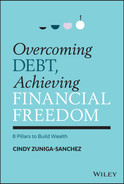Preface
In 2015, I graduated law school with honors and a job offer at a top national law firm. As the daughter of immigrants, from a low‐income community in the Bronx, these accomplishments were reflective of my commitment to honor my parents’ sacrifices and goal of achieving the American Dream. These milestones also surely held the key to financial success and security, right? Not necessarily.
My fancy law degree and new job could not mask my deep financial insecurities. I had $215,000 of debt, which consisted of $13,000 in credit card debt and $202,000 in student loans. I had little to no confidence in how I was managing my money. I didn't understand why my credit card balance continued to increase despite my timely payments. I was unaware that most of my payments to my student loans were going to the tens of thousands of dollars in accrued interest rather than the loans’ principal. I didn't know how to save for life's big expenses like a wedding or a down payment on a home … and don't even get me started on how clueless I was about investing.
Conversations about money, specifically debt, were uncommon and uncomfortable to have with family and friends, so I turned to books, podcasts, and the internet. My quest to become financially literate exposed me to a new world full of knowledge, strategies, guidance, and support that I desperately craved. I learned how to create a plan to pay off my six‐figure debt, which included targeted monthly payment amounts and even a goal debt‐free date that I wrote in bold lettering in my planner. I also learned how to budget, save an emergency fund, increase my net worth, improve my credit score, and open my first investment account.
This newfound world also revealed a new term: financial freedom. People in the personal finance community used it to describe a goal they were striving for in their money journeys. Everyone had their own interpretation. Some used it to refer to having enough money to absorb financial emergencies; for some it meant being able to comfortably afford their lifestyle; and for others it meant having enough money to quit their jobs and pursue their personal passions. When I first stumbled upon the term, I interpreted it as being debt‐free and having a specific dollar amount in the bank that would then—and only then—provide me with the financial security I desired. But my definition has since evolved.
Financial freedom is more than a fixed number or specific milestone. Financial freedom is when you no longer perceive money as a constant burden; rather, you perceive it as a tool that you control. It means having an intentional plan that allows you to work toward your money goals while unapologetically spending on what you value. It means stability that does not anxiously await the next paycheck. It means the flexibility to say yes to opportunities that will enrich your life and no to those that will not serve it.
Financial freedom is about confidently having the financial foundation to live your best life. For most of us, this involves learning a new language and topics that school or our upbringing may not have exposed us to. It involves incorporating newfound knowledge into our everyday lives and sharing that knowledge while encouraging conversations about money with our loved ones. Financial freedom takes time, patience, and—as this book will demonstrate—it requires a plan.
▪▪▪
When I sat down to write this book, I asked myself: What do you wish you knew about money when you started your financial freedom journey? What topics do you wish you had learned in school? What information has transformed your finances? What has helped you go from having six figures of debt to a six‐figure net worth?
▪▪▪
In the first few chapters of this book, I share my personal money story. I discuss the money lessons I learned as a first‐generation daughter of immigrants that have shaped my relationship with money, the financial hurdles I overcame in pursuit of the American Dream, and the why and how of conquering $215,000 of debt.
The core of this book is dedicated to the financial pillars that have been instrumental to my personal finances. Everything from conducting a financial audit, creating a plan to best manage your money, spending according to your values, saving for life's emergencies and significant expenses, creating a realistic plan to crush your debt, improving your credit score and becoming credit card savvy, growing your investment portfolio, and exploring ways to increase your income. These chapters are also full of examples to help you understand how these pillars are applied in practice.
The book wraps up with a financial roadmap summarizing these pillars and contains helpful checklists and templates so that you can get to work and start implementing them.
My hope is that this book will serve as your friendly guide to financial freedom. You can read it straight through from beginning to end or jump ahead to a chapter that resonates with you. You are not required to complete each pillar before moving on to the next. In fact, our personal finance journeys often require that we simultaneously balance various money goals—we might be saving an emergency fund while creating a debt repayment plan while improving our credit score. As you read through this book, I encourage you to highlight new terms and take notes. After you've read it, keep it as a resource that you can reference throughout your financial freedom journey.
I hope you're excited! Let's dive in.
